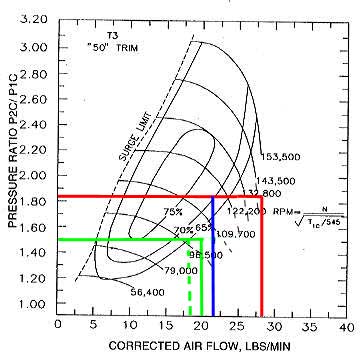Pressure ratio boost creep.
Ok, here is what I find. The absolute
pressure ratio with boost is given by (Pa+Pb)/Pa where Pa is ambient
pressure (atmospheric) and Pb is the differential boost pressure (what we
normally see on a boost gauge).
So lets take a nominal boost figure of 7.5
psi. At sea level we have (14.7+7.5)/14.7 = 1.51. First
looking at where sea level take off would put john on the compressor
chart Eric provided. I believe John's take off rpm is around
4000 rpm. That would give a mass flow of
approx 18 lbm/min. So that point is plotted on the
compressor map as the intersection of the dashed green lines and the solid
green. I also plotted his mass flow at 5000 rpm at sea level at 7.5
boost just so there would be a similar point of comparison at altitude, that
is the intersection of the two solid green lines..
Now John was at 11,000 feet so looking at
altitude charts it looks like Pa at that altitude would be about 9
psi. So if one was still maintaining a differential boost gauge
reading of 7.5 psi we would have (9+7.5)/9 = 1.83 pressure
ratio.
I don't recall John's rpm but I think it
was 5000rpm. That would give a compressor mass flow of 27.3 lbm at sea
level - that is the intersection of the two red lines -
However, that mass flow figured needs to be adjusted for
less dense air at 11000 feet that would bring it down to approx
22.7 lbm/min flow. That is the intersection of the red and blue
line.
As best I could eye ball it, that shows the
rotating assembly increased rpm by approx 12,000-15000 over the sea level
rpm just due to altitude pressure ratio creep along. The turbo had to
spin fast/work harder to maintain the 7.5 psi boost at altitude due to the
lower ambient pressure/density.
So clearly the effect of "altitude creep"
on pressure ratio (provide same boost level is maintained from sea to
altitude) is to cause the turbo to rotate faster. But, this
along does not appear to put it in a risk zone of
overspeeding. Would a BOV opening and possible adding to the rotation
speed take it there - don't know, can not show that it would or
would not.
Do notice however that the rpm lines of the
turbo tend to curve very steeply downward toward the right part of the
graph. So it would not take much more mass flow to put John's
operating point over further to the right into that region where the rpm
increases very dramatically for very little additional mass flow. If
Eric's postulation that a BOV opening adds to the mass flow through the
compressor is correct then would the BOV opening under those conditions be
enough to push the turbo into a danger zone??
Don't know can show it would or would
not. But, this makes me lean more toward over speeding as a possible
source of John's turbo failures. IF this analysis is anywhere close to
portraying what may have happened, I would think it would indicate
that a waste gate is a lesser risk approach to boost control for an aircraft
installation
FWIW.
Ed
Ed Anderson
RV-6A N494BW Rotary
Powered
Matthews, NC

Homepage: http://www.flyrotary.com/
Archive: http://lancaironline.net/lists/flyrotary/List.html